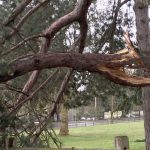Diseases Of Oak Trees
Let’s discuss a topic that many homeowners and property owners are concerned about: oak tree pests and diseases.
Majestic oak trees are beautiful, iconic pieces of the Pacific Northwest landscape. They make up a good percentage of our shared urban tree canopy (UTC).
While there are multiple oak tree varieties around the country, there are two that are dominant in Oregon: the Oregon white oak and the California black oak.
The California black oak is a deciduous tree that can grow up to 80 feet tall. The Oregon white oak can also grow up to be about 80 feet tall and is commonly seen in the Columbia Gorge.
Both trees produce acorns, and, in the past, Native Americans used them as a source of food — roasting, drying, and cooking them to put into bread and soup.
Pests and Diseases that Afflict Oak Trees
Unfortunately, oak trees can develop diseases and be impacted by pests.
Some of the most common insect pests are the oak leaftier, the gypsy moth, and the forest tent caterpillar.
There are also several diseases that commonly affect oak trees, including oak tatters, anthracnose, and oak wilt.
Anthracnose is a group of diseases that is related to fungi. It is common in white oak trees and is characterized by scattered brown spots and scorched, curled, or puckered leaves.
Apiognomonia errabunda is the specific fungus in that family that is commonly seen affecting oak trees around western Washington and Oregon.
Oak wilt is a common fungal infection that can kill the entire tree but is mainly seen in the eastern states of the country.
If you have an oak tree that has been negatively impacted by disease or an invasion of pests, the tree can often be saved by pruning dead branches, discarding the diseased leaves and branches, and then spraying it with a fungicide.
If the tree is not treated, it will likely die and not be salvageable.
Protect Your Oak Tree
To minimize your risk of tree disease or pests, proper care is the best defense. Keeping the trees watered, protecting their root system from damage, and applying mulch at the trunk regularly are some of the best ways to keep your trees healthy.
Not sure how to treat your infected oak trees — or if they’re infected at all? Perhaps you’re looking for preventative measures to ensure your trees remain healthy all year long.
Our experts at Inexpensive Tree Care can help. Contact us today to schedule an appointment with our tree care experts.
Be sure to let us know if you have any specific questions or concerns, such as possibly infected trees, root rot, leaf surfaces that turn brown, sooty mold on oak leaves, oak leaf blisters, or premature leaf drop and fruiting bodies. These may be signs of oak tree pests and diseases.
We want you to have healthy trees, from early spring and all throughout the year. So get in touch with us, and we’ll diagnose whatever problems you may be experiencing in your own little piece of the UTC.



